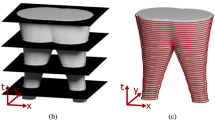Abstract
In this paper, we introduce a novel method to hierarchically decompose the animated 3d object efficiently by utilizing high-dimensional and multi-scale geometric information. The key idea is to treat the animated surface sequences as a whole and extract the near-rigid components from it. Our approach firstly detects a set of the multi-scale feature points on the animated object and computes approximately invariant signature vectors for these points. Then, exploiting both the geometric attributes and the local signature vector of each point (vertex) of the animated object, all the points (vertices) of the animated object can be clustered efficiently using a GPU-accelerated mean shift clustering algorithm. To refine the decomposition boundaries, the initially-generated boundaries of the animated object can be further improved by applying a boundary refinement technique based on Gaussian Mixture Models (GMMs). Furthermore, we propose a hierarchical decomposition technique using a topology merging strategy without introducing additional computations.
Our animated object decomposition approach does not require the topological connectivity of the animated object, thus it can be applied for both triangle mesh and point-sampled geometry sequences. The experimental results demonstrate that our method achieves both good quality results and high performance for the decomposition of animated object.
Similar content being viewed by others
References
Adams, A., Gelfand, N., Dolson, J., Levoy, M.: Gaussian kd-trees for fast high-dimensional filtering. ACM Trans. Graph. 28, 21:1–21:12 (2009)
Attene, M., Patanè, G.: Hierarchical structure recovery of point-sampled surfaces. In: Computer Graphics Forum, vol. 29, pp. 1905–1920. Wiley, New York (2010)
Chen, X., Golovinskiy, A., Funkhouser, T.: A benchmark for 3d mesh segmentation. ACM Trans. Graph. 28, 73:1–73:12 (2009)
Chu, H.K., Lee, T.Y.: Multiresolution mean shift clustering algorithm for shape interpolation. IEEE Trans. Vis. Comput. Graph. 15, 853–866 (2009)
Desbrun, M., Meyer, M., Schröder, P., Barr, A.H.: Implicit fairing of irregular meshes using diffusion and curvature flow. In: SIGGRAPH, pp. 317–324 (1999)
Edelsbrunner, H., Harer, J., Zomorodian, A.: Hierarchical morse complexes for piecewise linear 2-manifolds. In: Proceedings of the Seventeenth Annual Symposium on Computational Geometry, pp. 70–79 (2001)
Gal, R., Cohen-Or, D.: Salient geometric features for partial shape matching and similarity. ACM Trans. Graph. 25(1), 150 (2006)
Georgescu, B., Shimshoni, I., Meer, P.: Mean shift based clustering in high dimensions: A texture classification example. In: ICCV, p. 456 (2003)
Golovinskiy, A., Funkhouser, T.: Consistent segmentation of 3D models. Comput. Graph. 33(3), 262–269 (2009)
Huang, Q., Adams, B., Wicke, M., Guibas, L.: Non-rigid registration under isometric deformations. In: Proceedings of the Symposium on Geometry Processing, pp. 1449–1457. Eurographics Association, Geneva (2008)
James, D.L., Twigg, C.D.: Skinning mesh animations. ACM Trans. Graph. 24, 399–407 (2005)
Katz, S., Leifman, G., Tal, A.: Mesh segmentation using feature point and core extraction. Vis. Comput. 21(8–10), 649–658 (2005)
Lee, T.Y., Lin, P.H., Yan, S.U., Lin, C.H.: Mesh decomposition using motion information from animation sequences: animating geometrical models. Comput. Animat. Virtual Worlds 16, 519–529 (2005)
Lee, T.Y., Wang, Y.S., Chen, T.G.: Segmenting a deforming mesh into near-rigid components. Vis. Comput. 22, 729–739 (2006)
Lewis, J.P., Cordner, M., Fong, N.: Pose space deformation: a unified approach to shape interpolation and skeleton-driven deformation. In: SIGGRAPH, pp. 165–172 (2000)
Li, H., Sumner, R., Pauly, M.: Global correspondence optimization for non-rigid registration of depth scans. In: Computer Graphics Forum. Wiley Online Library, vol. 27, pp. 1421–1430 (2008)
Guskov I., Li X.: Multi-scale features for approximate alignment of point-based surfaces. In: Proceedings of the Third Eurographics Symposium on Geometry Processing, p. 217. Eurographics Association, Geneva (2005)
Lowe, D.G.: Distinctive image features from scale-invariant reypoints. Int. J. Comput. Vis. 60, 91–110 (2004)
NVIDIA: Cuda technology. http://www.nvidia.com/CUDA (2007)
Paris, S., Durand, F.: A topological approach to hierarchical segmentation using mean shift. In: IEEE Conference on Computer Vision and Pattern Recognition, 2007. CVPR’07, pp. 1–8. IEEE Press, New York (2007)
Popa, T., Julius, D., Sheffer, A.: Material-aware mesh deformations. In: Proc. of IEEE SMI 2006, p. 22 (2006)
Sattler, M., Sarlette, R., Klein, R.: Simple and efficient compression of animation sequences. In: ACM SIGGRAPH/Eurographics SCA, pp. 209–217 (2005)
Shamir, A.: A survey on mesh segmentation techniques. Comput. Graph. Forum 27(6), 1539–1556 (2008)
Shapira, L., Shalom, S., Shamir, A., Cohen-Or, D., Zhang, H.: Contextual part analogies in 3D objects. Int. J. Comput. Vis. 89(2), 309–326 (2010)
Tierny, J., Vandeborre, J.P., Daoudi, M.: Invariant high level reeb graphs of 3d polygonal meshes. In: 3DPVT’06, pp. 105–112 (2006)
Wuhrer, S., Brunton, A.: Segmenting animated objects into near-rigid components. Vis. Comput. 26(2), 147–155 (2010)
Xiao, C., Liu, M.: Efficient mean-shift clustering using Gaussian KD-tree. In: Computer Graphics Forum. Wiley Online Library, vol. 29, pp. 2065–2073 (2010)
Xiao, C., Zheng, W., Peng, Q., Forrest, A.: Robust morphing of point-sampled geometry. Comput. Animat. Virtual Worlds 15(3–4), 201–210 (2004)
Xiao, C., Miao, Y., Liu, S., Peng, Q.: A dynamic balanced flow for filtering point-sampled geometry. Vis. Comput. 22, 210–219 (2006)
Yamauchi, H., Lee, S., Lee, Y., Ohtake, Y., Belyaev, A., Seidel, H.P.: Feature sensitive mesh segmentation with mean shift. In: Shape Modeling and Applications 2005, pp. 238–245 (2005)
Zhou, K., Hou, Q., Wang, R., Guo, B.: Real-time kd-tree construction on graphics hardware. ACM Trans. Graph. 27, 126:1–126:11 (2008)
Author information
Authors and Affiliations
Corresponding author
Electronic Supplementary Material
Below is the link to the electronic supplementary material.
Rights and permissions
About this article
Cite this article
Liao, B., Xiao, C., Liu, M. et al. Fast hierarchical animated object decomposition using approximately invariant signature. Vis Comput 28, 387–399 (2012). https://doi.org/10.1007/s00371-011-0625-4
Published:
Issue Date:
DOI: https://doi.org/10.1007/s00371-011-0625-4




